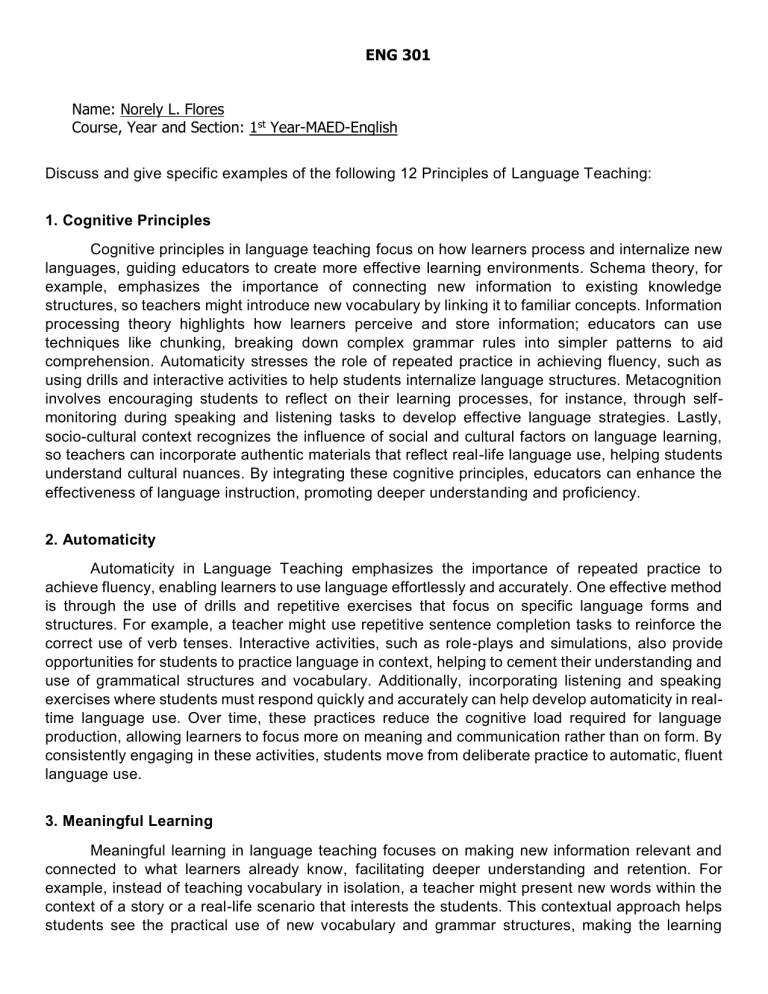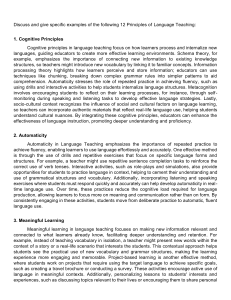
ENG 301 Name: Norely L. Flores Course, Year and Section: 1st Year-MAED-English Discuss and give specific examples of the following 12 Principles of Language Teaching: 1. Cognitive Principles Cognitive principles in language teaching focus on how learners process and internalize new languages, guiding educators to create more effective learning environments. Schema theory, for example, emphasizes the importance of connecting new information to existing knowledge structures, so teachers might introduce new vocabulary by linking it to familiar concepts. Information processing theory highlights how learners perceive and store information; educators can use techniques like chunking, breaking down complex grammar rules into simpler patterns to aid comprehension. Automaticity stresses the role of repeated practice in achieving fluency, such as using drills and interactive activities to help students internalize language structures. Metacognition involves encouraging students to reflect on their learning processes, for instance, through selfmonitoring during speaking and listening tasks to develop effective language strategies. Lastly, socio-cultural context recognizes the influence of social and cultural factors on language learning, so teachers can incorporate authentic materials that reflect real-life language use, helping students understand cultural nuances. By integrating these cognitive principles, educators can enhance the effectiveness of language instruction, promoting deeper understanding and proficiency. 2. Automaticity Automaticity in Language Teaching emphasizes the importance of repeated practice to achieve fluency, enabling learners to use language effortlessly and accurately. One effective method is through the use of drills and repetitive exercises that focus on specific language forms and structures. For example, a teacher might use repetitive sentence completion tasks to reinforce the correct use of verb tenses. Interactive activities, such as role-plays and simulations, also provide opportunities for students to practice language in context, helping to cement their understanding and use of grammatical structures and vocabulary. Additionally, incorporating listening and speaking exercises where students must respond quickly and accurately can help develop automaticity in realtime language use. Over time, these practices reduce the cognitive load required for language production, allowing learners to focus more on meaning and communication rather than on form. By consistently engaging in these activities, students move from deliberate practice to automatic, fluent language use. 3. Meaningful Learning Meaningful learning in language teaching focuses on making new information relevant and connected to what learners already know, facilitating deeper understanding and retention. For example, instead of teaching vocabulary in isolation, a teacher might present new words within the context of a story or a real-life scenario that interests the students. This contextual approach helps students see the practical use of new vocabulary and grammar structures, making the learning experience more engaging and memorable. Project-based learning is another effective method, where students work on projects that require using the target language to achieve specific goals, such as creating a travel brochure or conducting a survey. These activities encourage active use of language in meaningful contexts. Additionally, personalizing lessons to students' interests and experiences, such as discussing topics relevant to their lives or encouraging them to share personal stories, can make language learning more meaningful. By integrating these strategies, teachers can foster an environment where students are more motivated and better able to internalize and apply the new language. 4. Anticipation of Rewards Anticipation of rewards in language teaching leverages the motivational power of incentives to enhance student engagement and effort. This principle involves using both intrinsic and extrinsic rewards to encourage language learning. For example, a teacher might set up a points system where students earn points for participation, correct answers, or completing assignments, which can later be exchanged for small prizes or privileges, like extra recess time or a homework pass. Additionally, verbal praise and positive feedback can serve as powerful intrinsic rewards, reinforcing students' confidence and willingness to participate. Another example is using a gamified learning approach, where students progress through levels or earn badges for mastering certain language skills. These tangible rewards create a sense of achievement and motivation. Incorporating goal-setting, where students set personal language learning targets and receive recognition upon achieving them, also harnesses the anticipation of rewards. By strategically using rewards, teachers can create a motivating and supportive learning environment that encourages sustained effort and progress in language acquisition. 5. Intrinsic Motivation Intrinsic motivation in language teaching refers to the internal drive that encourages students to learn because they find the process enjoyable and satisfying, rather than for external rewards. To foster this type of motivation, teachers can create engaging and meaningful learning experiences. For example, incorporating topics that interest students, such as their hobbies, favorite books, or current events, can make lessons more relevant and enjoyable. Using interactive activities like role plays, debates, and group projects allows students to actively use the language in a fun and dynamic way. Encouraging self-directed learning, where students set their own goals and choose activities that match their interests, also promotes intrinsic motivation. Additionally, providing opportunities for authentic communication, such as pen pal exchanges or video chats with native speakers, helps students see the real-world application of their language skills. By focusing on these strategies, teachers can help students develop a love for language learning that goes beyond grades or external rewards. 6. Strategic investment Strategic investment in language teaching involves helping students develop and use effective learning strategies to enhance their language acquisition. This approach emphasizes teaching students how to learn, rather than just what to learn. For example, a teacher might introduce specific vocabulary learning techniques, such as using flashcards, mnemonic devices, or vocabulary mapping, to help students retain new words more efficiently. Another strategy is training students in metacognitive skills, such as self-monitoring and self-assessment, where students regularly evaluate their own progress and adjust their study methods accordingly. Teachers can also encourage the use of language learning tools, like language apps, online dictionaries, and language exchange platforms, to supplement classroom instruction. Additionally, incorporating collaborative learning strategies, such as peer teaching and group work, can help students learn from each other and develop critical thinking skills. By investing in these strategic approaches, teachers empower students to become more autonomous, confident, and effective language learners. 7. Autonomy Autonomy in language teaching focuses on empowering students to take control of their own learning process, fostering independence and self-regulation. This can be achieved by encouraging students to set their own learning goals and track their progress. For example, teachers can guide students in creating personalized study plans that outline specific language objectives and the steps needed to achieve them. Allowing students to choose topics of interest for projects or presentations can also enhance their engagement and motivation. Another approach is to incorporate selfassessment tools, such as learning journals or portfolios, where students regularly reflect on their learning experiences and outcomes. Additionally, providing access to a variety of language resources, such as online platforms, books, and media, enables students to explore and learn at their own pace. By promoting autonomy, teachers help students develop a sense of responsibility and intrinsic motivation, which are crucial for sustained language learning success. 8. Socio-affective Principle The socio-affective principle in language teaching emphasizes the importance of social interaction and emotional well-being in the learning process. Creating a supportive and collaborative classroom environment can enhance students' language acquisition by reducing anxiety and building confidence. For example, teachers can implement group activities such as discussions, role-plays, and peer feedback sessions that encourage students to communicate and learn from each other. Additionally, fostering a positive teacher-student relationship through active listening, empathy, and constructive feedback helps students feel valued and motivated. Incorporating activities that address students' interests and cultural backgrounds also makes learning more relevant and engaging. Teachers can organize language exchange partnerships or cultural projects that allow students to practice language skills while building meaningful connections. By integrating these socio -affective strategies, educators can create a nurturing environment that supports both the emotional and social aspects of language learning, ultimately enhancing student engagement and success. 9. Language Ego Language ego refers to the identity and self-esteem issues that arise when learners use a new language, impacting their confidence and willingness to communicate. To address language ego in language teaching, creating a supportive and non-judgmental classroom environment is crucial. For example, teachers can establish a classroom culture where mistakes are seen as a natural part of the learning process, encouraging students to take risks without fear of criticism. Activities like collaborative group work and pair discussions can help students build confidence by practicing language in a low-pressure setting. Additionally, incorporating positive reinforcement and personalized feedback can boost students' self-esteem and motivation. Role-playing activities that simulate real-life scenarios can also help students feel more comfortable using the language in practical contexts. By being mindful of language ego and implementing these strategies, teachers can help students develop a positive self-image as language learners, increasing their confidence and willingness to participate actively in language learning activities. 10. Willingness to Communicate Willingness to communicate (WTC) in language teaching refers to learners' motivation and readiness to initiate and engage in communication in the target language. Creating an environment that fosters WTC is crucial for developing students' language proficiency and confidence. For example, teachers can design classroom activities that encourage frequent opportunities for speaking and interaction, such as debates, discussions, and presentations. Providing clear communication goals and meaningful contexts can motivate students to use the language authentically. Moreover, incorporating activities that cater to different learning styles and preferences, such as collaborative projects, role-plays, or digital storytelling, can boost students' comfort and willingness to participate actively. Encouraging peer interaction and offering constructive feedback also helps students feel supported and motivated to communicate. By nurturing willingness to communicate through these strategies, educators empower students to develop fluency and competence in the target language while fostering a positive learning atmosphere. 11. Language Culture Connection Language culture connection in language teaching emphasizes the integration of cultural contexts and practices into language learning to enhance students' understanding and appreciation of both language and culture. For example, teachers can incorporate authentic cultural materials such as literature, films, music, and art from the target language's culture. Analyzing these materials not only improves language skills but also deepens students' cultural awareness and sensitivity. Additionally, engaging students in activities that explore cultural norms, traditions, and values through discussions or role-plays helps them grasp the nuances of language use within different cultural contexts. Encouraging language exchange programs or inviting guest speakers from diverse cultural backgrounds further enriches students' exposure to real-world language and cultural practices. By bridging language and culture in teaching, educators not only enhance students' linguistic proficiency but also promote intercultural competence and appreciation, preparing them for effective communication in a globalized world. 12. Interlanguage Interlanguage in language teaching refers to the dynamic and evolving linguistic system that learners develop as they acquire a new language. It reflects learners' ongoing attempts to use the target language, incorporating elements of their native language and adjusting to new linguistic rules and patterns. For example, a learner might initially overgeneralize a grammar rule from their native language when speaking or writing in the target language. Teachers can address interlanguage by providing corrective feedback that guides learners toward more accurate language use without discouraging communication. Additionally, understanding learners' interlanguage helps educators tailor instruction to address specific linguistic challenges and scaffold learning appropriately. Activities that encourage learners to experiment with language, such as communicative tasks and role-plays, can facilitate the development of more fluent and accurate interlanguage. By acknowledging and supporting learners' interlanguage development, teachers create an inclusive and effective learning environment that promotes continuous language growth and proficiency.

